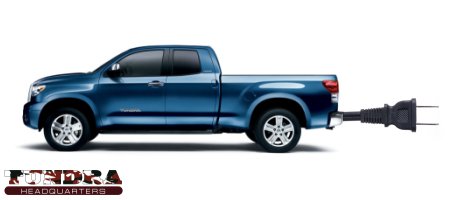
 Author Archive for Jason Lancaster
Author Archive for Jason Lancaster
Jason Lancaster is the editor and founder of TundraHeadquarters.com. He has nearly a decade of experience on the retail side of the auto industry, and another decade of experience of the part and accessory side of the industry.
The Case for the Plug-in Electric Pickup
Plug-in electric cars are on the way. Both mainstream automakers and boutique brands are aiming to capitalize on the growing desire amongst drivers to wean themselves off gasoline. While gasoline / electric hybrids have been around for years, the idea of a pure electric vehicle – one which runs exclusively off of a battery and must be recharged by plugging in to a standard electrical socket – is for many the ultimate goal of the hybrid revolution.
While automakers are developing plug-in hybrids, it’s important to note that most of the plug-in hybrid vehicles being introduced are sedans and coupes – not trucks. Automakers have yet to embrace the concept of a plug-in pickup, and some green types are using this fact to argue that the days of big pickups are over. However, the fact is many people need a truck for work and/or their daily lives. So why haven’t automakers started producing plug-in pickups? It’s not size…at least not completely.

Where is the Electric Toyota Tundra?
Pickups are big, and their larger dimensions might seem to be the reason that automakers aren’t producing hybrid versions. After all:
- Most hybrid electric vehicles on the market are small.
- It takes a more powerful electric motor to get a big pickup rolling.
However, size isn’t really the problem…kind of.
5 Ways Toyota Is Screwing Up The Tundra
Toyota needs to stop being so damn conservative when it comes to the Tundra. Since 2007, Toyota has built a truck that can stand toe-to-toe with the best that Ford, GM, and Dodge had to offer. Never before has Toyota offered a truck with so much capability at such a great value. Consumers responded strongly to the new Tundra in 2007, and that response stayed strong through the debut of the TRD supercharger in 2008. After that, enthusiasm started to sputter. Toyota started out winning the battle for the hearts and minds of truck owners, but then they pulled back. What gives?
While it’s easy to blame a downturn in the truck market (and aggressive incentives from struggling domestic rivals) for the Tundra’s loss of momentum, the problem is deeper than that. The problem, plain and simple, is Toyota’s poor management of the development of the Tundra. Here’s what they’ve done wrong:
09 F150 and Ram Recalls and Funny Pictures
Just in case you missed it last week, there were a couple of “little” recalls on the 2009 Ford F150 and the 2009 Dodge Ram. Nothing big mind you, just a couple of small items that won’t be a big deal (unless of course they become a big deal).
First, the Ram. According to TruckBlog.com:
Chrysler has issued a recall of nearly 40,000 2009 Dodge Ram light duty pickup trucks equipped with the manual temperature control where the software programmed for the heating ventilation and air condition module may cause the defrosting and defogging functions to become non-functional. The result of this can lead to a decrease in visibility and raise the chance of crashing.
No big deal really…unless your defroster doesn’t work and you can see out of the winsheild. At least you can stick your head out the window.
2009 Dodge Ram owners might have to stick their heads out of their trucks.
![]() photo credit: Fillmore Photography
photo credit: Fillmore Photography
Next up, Ford’s minor recall for the 2009 F150. According to Edmunds.com:
Ford is recalling 8,735 of its 2009 F-150 trucks because a faulty brake stop lamp switch may cause the brake lights to fail to illuminate
No big deal – unless someone is counting on seeing your brake lights to keep from running into you (you know, like while driving).
Every manufacturer has recalls (and both of these are relatively minor), and we’re certainly not trying to make light of the safety risks these recalls present, but the next time a Ford or Dodge owner razzes you about your Tundra, you know what to hit them back with. Now for a couple of funny pictures:
New Fuel Economy Rules Won’t Stop Big Trucks – Big V8s Are Here Forever
The Obama administration seems to have solidified the direction of fuel economy and emissions regulations for the next decade. Here’s the basics of the plan laid down yesterday:
- An automaker’s “fleet average” – i.e. the average fuel economy of all the vehicles an automaker sells adjusted by sales volume – must be 35.5 mpg by 2016 (up from 2009’s fleet requirement of 25 mpg).
- CO2 emissions have to drop to 250 grams per mile (down from 380).
- Plug-in electric and hydrogen powered vehicles will qualify for “super credits” – meaning that selling one plug-in electric and/or hydrogen powered vehicle will cancel out 2 or more “regular” vehicles.
These new rules are great for the environment and widely popular, and considering that all the auto manufacturers have signed off on the plan (as well as the UAW), this looks as good as done. So, the question for us is, What do these new fuel economy and emissions rules mean for pickup trucks?
Motor Trend Likes F150 Despite Tundra Being Better
Here’s a new one – Motor Trend’s recent 2009 F150 vs 2009 Toyota Tundra comparison found that the Tundra had the following advantages:
- The Tundra handled better.
- The Tundra had more visibility.
- The Tundra had more room.
- The Tundra had more power.
- The Tundra was a better towing rig both up and down the hill.
- The Tundra was less expensive.
The winner? Why the F150 of course! I’m not making any of this up folks – all of that info was in the article.


